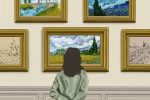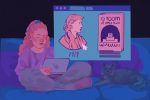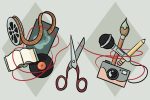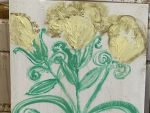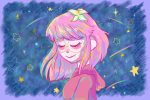
Squiggles, zig-zags, crescents and curlicues, generally of the pastel variety, bounce across the white backgrounds of painter and graphic designer Will Bryant with alarming verve. The artist, whose home base is Austin, Texas, has developed a signature style so recognizable that he’s landed branding opportunities with companies as diverse in their clientele as Google, Coca Cola and The New York Times Magazine.
More recently, the congenial father of two has dipped his toe into the hospitality industry, serving as the creative director behind and partner in a new bar and eatery, Last Straw. With every passing day, his imprint on Austin becomes harder and harder to overlook, as a Will Bryant design increasingly seems to be the hallmark of a trendy new outpost.
I had the pleasure of speaking to Bryant about his work, his inspiration and how he made art work for him.
Lily Harrington: To start off, how did you get started as an artist? Did you always know this was going to be your career path?
Will Bryant: This is a layered answer to an abstract question. In third grade I said I wanted to be an architect because my older brother was in school for architecture. In high school I had a T-shirt line with a buddy in which we made about a total of 20 shirts using hand-cut stencils and fabric blow-pens (the opposite of efficient/profitable).
The best answer would be my sophomore year studying at Mississippi State University when I took an intro graphic design course with Kate Bingaman-Burt. She changed my world forever. I grew up in a small East Texas town playing sports, trying to standout while trying to fit in and rarely drawing.
For almost a decade I’ve worked full time as an illustrator/graphic designer. I’ve tried to position myself more as an artist for hire that is fun, approachable and easy to work with.

I often collaborate with brands on promotional projects, apparel, editorial illustration, packaging, visual identities and murals/installations. I also have a strong desire to make more gallery work, which continues to alter my creative path.
LH: What life experiences have shaped you as an artist or played into your artistic vision?
WB: There’s a mash-up of interests that are rooted in my childhood: playing sports, being a jokester, manners/Southern hospitality and growing up in front a screen (over-stimulation).
LH: Who/what has been your biggest influence as an artist?
WB: Kate Bingaman-Burt and “Pee-wee’s Playhouse.”
LH: Where do you find most of your support?
WB: My wife, studio mates, family and friends. My parents have always been very supportive of me in anything I’ve pursued. I am very grateful for that. Whether they have understood what or why I was doing something is an entirely different conversation. With that said, I was constantly encouraged by friends and family to pursue what I was passionate about.
LH: What gets you up in the morning?
WB: My 4-year-old daughter. I normally have to wipe her butt after she goes to the restroom.
LH: Are you a Texas native? Has Texas been an inspiration for you in anyway? I’ve noticed a number of your pieces are dominated by whitespace, which translates, to me, as a sort of desert feel.
WB: I was born in Murfreesboro, Tennessee, but grew up in Texarkana, Texas, and made lots of trips to Mississippi (for extended family). That negative space is more credited to a background in graphic design rather than landscape. There was not much negative space in my earlier work.
LH: What’s your favorite philosophy to live by, and how has that helped shape you as an artist?
WB: “Sure, I Like Fun.” If I’m not enjoying what I’m doing or I’m not helping someone else from it, then what’s the point?
LH: Do you produce every day, or just when you’re feeling inspired?
WB: I mostly produce when necessary. When starting out my career, it was closer to every day. Now it depends on schedule, current projects and my mood.
But even if I’m not producing (a physical piece) I’m likely problem-solving or thinking about a project in the back of my mind. Or doubting everything I’ve ever made, does that count as productive? (It doesn’t.)

LH: Entering the artistic scene can be difficult — did you find it difficult to get your name out there?
WB: My amazing mentor Kate really helped get my name out there. I also was involved with the design-blog community and would share other young creatives’ work and playlists, and connected with people that way. Everything is difficult at some point, and everything takes time. I think people starting out in their careers really need to give themselves permission to take their time.
LH: Do you ever run out of inspiration? What do you do to refuel the artistic flame if you’re in a rut?
WB: All the time. I feel best on days I run, work out or play basketball. Being in nature and moving around feels really good. I think running the greenbelt is the BEST. My favorite spot is the Violet Crown Trail (360 to 290).
LH: Do you see art as a lifelong occupation, or are you open to other careers outside of the artistic world?
WB: I plan to make work as long as it makes sense and brings me joy. As for the occupational side, it depends on what I need to do to support my family.
Currently, this is what provides a living for us and I am very thankful to be able to do it. But yes, I’m open to it, that’s why I’m a partner in a restaurant/bar!

LH: What is your preferred medium and why?
WB: I don’t know if I have a favorite. Sometimes I love painting, but not everything I paint.
LH: What do you think separates your work from your contemporaries who perhaps work in a similar style?
WB: I think my personality, interests and sense of humor come through my work. It might look similar to others’, but the range of work that I produce is fairly broad, yet feels like it’s from me. At least, this is what I keep telling myself.
LH: What is your preferred media platform and why?
WB: Instagram, internet, word-of-mouth, etc.? Xanga is where I first experimented with my voice (online). MySpace allowed me to experiment with style. I prefer a balance of all of those platforms. I think they all are necessary, for the moment, in some capacity.
Instagram has worked well for me, but it’s far from perfect. I like that people from near and far can see what I’m up to, but I do prefer face-to-face connection with other humans. I’m pretty good at keynote presentations; maybe I should do some door-to-door canvasing with my work?
LH: Color seems to be one of the most prominent aspects of your work. How do you see color as a driving force for your work?
WB: Color is a feeling and very necessary.
LH: What has been your favorite project and why?
WB: I think my favorite project to date would be working on an Adidas project for the NBA All Star Weekend 2017 in New Orleans. A lot of my childhood dreams and current interests came together in the form of a mini basketball court installation that I covered in wild linework over the course of three days.
I mingled with NBA/WNBA stars, dribbled and dunked on a court that I covered with my work and loved everyone involved. Every aspect of the project was really incredible, from the agency, the client, other artists involved and the food. So good!
To top it off, my wife was my assistant for the project and we went on dates every night (without the kiddo)! This is one of those projects that 8-year-old Will and 33-year-old Dad Will are equally stoked on. There are several other projects that I love, but I think I was supposed to pick one.

LH: What has been the biggest challenge you have faced as an artist?
WB: Making art and involving money in the process.
LH: You do a lot of brand work. How do you collaborate with your clients to both adhere to their needs while maintaining your own artistic vision?
WB: Graduate school helped me with discernment in regard to working with brands or exploring ideas on my own. At heart, I really want to please people, not always for the attention, but I want people to feel included in what’s going on. I think that temperament allows me to collaborate with brands, as long as there is a budget and the people behind the brand are interested in working with me.
I think that’s the other important component — there are wonderful humans at agencies, brands and companies that seek out projects that align with my aesthetic and personality. In those situations it’s very easy to maintain my integrity, because I have advocates for my work on both sides (my agents and the agency working closely with the brand). That relationship lends itself to a fun project.
LH: Your work is simple yet dynamic — does this translate better on a larger or smaller scale?
WB: It depends on the approach. Some work is more suitable as a sticker or T-shirt graphic. Other pieces need scale, texture and perspective to make them feel more impactful. I dunno, you choose!
LH: In the same breath, I’ve also noticed you do a lot of large-scale, mural installations. What is it like to see your work displayed in public like that?
WB: It’s incredible! Both very pleasing and very vulnerable. I love that people feel connected to something that I’ve made and see it everyday, but it’s not for everyone — that’s the vulnerable part. “If you don’t like my mural, do you not like me?” Ha.
LH: These installations seem to liven up the spaces they occupy — what do you think makes your work come to life?
WB: Scale helps so much, but there’s also a rhythm to my work. It’s repetitive, but not systematic. The subtle variation in the contours and forms creates funky baseline.
LH: There has been a sort of shift back to ’80s-esque patterns, and there seems to be some of this influence in your work — does it bear any significance?
WB: Yes there has, that shift is a resurgence of the Memphis movement. It has been an influence on me — through various pop-culture outlets and thrift-store adaptations — before I even knew what it was.
I’m a big fan and loved seeing its influence on “Pee-wee’s Playhouse” as a kid. The driving force behind that movement was a reaction to ’70s minimalism. The explosion of color, form and playfulness certainly parallels my own work.
During grad school I spent time researching Sottsass’ work and became infatuated with his essay “When I Was a Very Small Boy,” written in 1973. He speaks of this yearning to play, to experiment without the distractions of an adult.
“I’d like to find somewhere to try out things, together, things to do with our hands or machines, in any way, not like boy scouts or even like craftsmen and not even like workers and still less like artists, but like men with arms, legs, hands, feet, hairs, sex, saliva, eyes and breath, and to do them, certainly not to possess things and to keep them for ourselves and not even to give them to others, but just feel what it’s like to do things by trying to do them, trying to find out whether everyone can do things, other things, with their hands or machines — or whatever — etcetera etcetera. Can it be tried?” — Ettore Sottsass



LH: Your work is both static and fluid — individual components make a larger, more unified whole. How does movement play into your art?
WB: I really like things that bounce your eye around and there’s not one clear focal point. You know, like “Where’s Waldo,” for instance. I stared at those books for hours.
As I’ve progressed in my career (gotten old-er-er), I keep working with constraints to do the same thing in different ways. Basically, to keep myself interested in what I’m doing.
So sometimes I create a zany, bouncy pattern, but then I might respond to that with something more minimal and airy. The movement between the two creates an interesting relationship. “Good question, I don’t know” is my other response to this question. ¯\_(ツ)_/¯
LH: What kind of, if any, social issues are you trying to communicate through your work?
WB: I’m hesitant to initiate projects around social issues on my own, but would rather use my platform/privilege to help promote a voice that needs to be heard.
I’m trying to be self-aware of my privilege comes through. A white male from a small suburb making happy work — it’s not a very interesting backstory. I’ve tried to make more serious work, but it just doesn’t fit.
LH: What is your favorite subject matter and why? Abstract? Sketching? Cartoon drawing? Representational?
WB: My favorite subject matter is fun.




